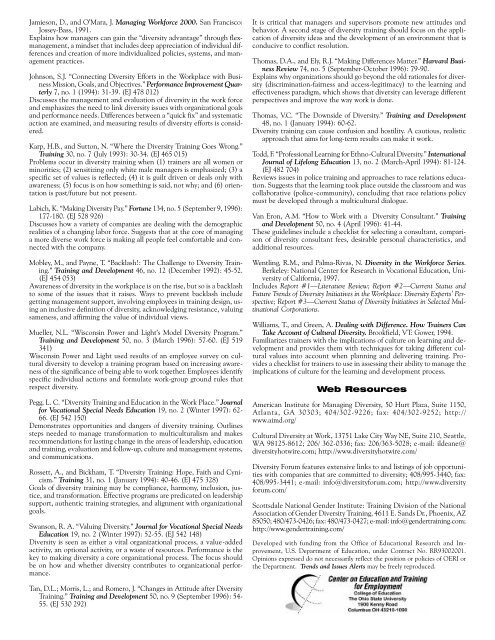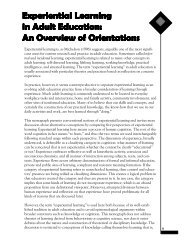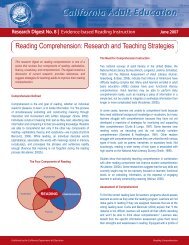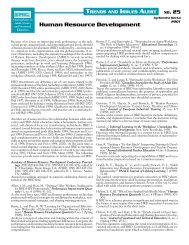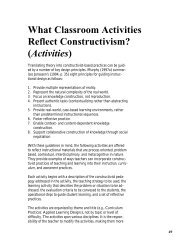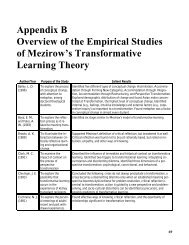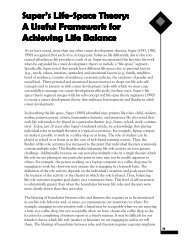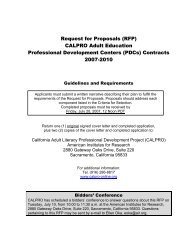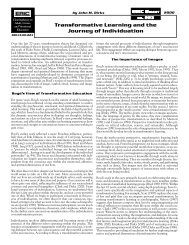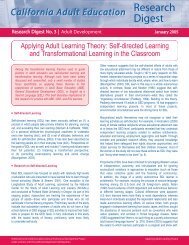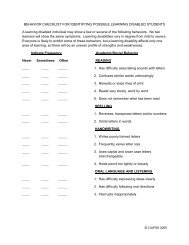ALERTS - CALPRO
ALERTS - CALPRO
ALERTS - CALPRO
You also want an ePaper? Increase the reach of your titles
YUMPU automatically turns print PDFs into web optimized ePapers that Google loves.
Jamieson, D., and O’Mara, J. Managing Workforce 2000. San Francisco:Jossey-Bass, 1991.Explains how managers can gain the “diversity advantage” through flexmanagement,a mindset that includes deep appreciation of individual differencesand creation of more individualized policies, systems, and managementpractices.Johnson, S.J. “Connecting Diversity Efforts in the Workplace with BusinessMission, Goals, and Objectives.” Performance Improvement Quarterly7, no. 1 (1994): 31-39. (EJ 478 012)Discusses the management and evaluation of diversity in the work forceand emphasizes the need to link diversity issues with organizational goalsand performance needs. Differences between a “quick fix” and systematicaction are examined, and measuring results of diversity efforts is considered.Karp, H.B., and Sutton, N. “Where the Diversity Training Goes Wrong.”Training 30, no. 7 (July 1993): 30-34. (EJ 465 015)Problems occur in diversity training when (1) trainers are all women orminorities; (2) sensitizing only white male managers is emphasized; (3) aspecific set of values is reflected; (4) it is guilt driven or deals only withawareness; (5) focus is on how something is said, not why; and (6) orientationis past/future but not present.Labich, K. “Making Diversity Pay.” Fortune 134, no. 5 (September 9, 1996):177-180. (EJ 528 926)Discusses how a variety of companies are dealing with the demographicrealities of a changing labor force. Suggests that at the core of managinga more diverse work force is making all people feel comfortable and connectedwith the company.Mobley, M., and Payne, T. “Backlash!: The Challenge to Diversity Training.”Training and Development 46, no. 12 (December 1992): 45-52.(EJ 454 053)Awareness of diversity in the workplace is on the rise, but so is a backlashto some of the issues that it raises. Ways to prevent backlash includegetting management support, involving employees in training design, usingan inclusive definition of diversity, acknowledging resistance, valuingsameness, and affirming the value of individual views.Mueller, N.L. “Wisconsin Power and Light’s Model Diversity Program.”Training and Development 50, no. 3 (March 1996): 57-60. (EJ 519341)Wisconsin Power and Light used results of an employee survey on culturaldiversity to develop a training program based on increasing awarenessof the significance of being able to work together. Employees identifyspecific individual actions and formulate work-group ground rules thatrespect diversity.Pegg, L. C. “Diversity Training and Education in the Work Place.” Journalfor Vocational Special Needs Education 19, no. 2 (Winter 1997): 62-66. (EJ 542 150)Demonstrates opportunities and dangers of diversity training. Outlinessteps needed to manage transformation to multiculturalism and makesrecommendations for lasting change in the areas of leadership, educationand training, evaluation and follow-up, culture and management systems,and communications.Rossett, A., and Bickham, T. “Diversity Training: Hope, Faith and Cynicism.”Training 31, no. 1 (January 1994): 40-46. (EJ 475 328)Goals of diversity training may be compliance, harmony, inclusion, justice,and transformation. Effective programs are predicated on leadershipsupport, authentic training strategies, and alignment with organizationalgoals.Swanson, R. A. “Valuing Diversity.” Journal for Vocational Special NeedsEducation 19, no. 2 (Winter 1997): 52-55. (EJ 542 148)Diversity is seen as either a vital organizational process, a value-addedactivity, an optional activity, or a waste of resources. Performance is thekey to making diversity a core organizational process. The focus shouldbe on how and whether diversity contributes to organizational performance.It is critical that managers and supervisors promote new attitudes andbehavior. A second stage of diversity training should focus on the applicationof diversity ideas and the development of an environment that isconducive to conflict resolution.Thomas, D.A., and Ely, R.J. “Making Differences Matter.” Harvard BusinessReview 74, no. 5 (September-October 1996): 79-90.Explains why organizations should go beyond the old rationales for diversity(discrimination-fairness and access-legitimacy) to the learning andeffectiveness paradigm, which shows that diversity can leverage differentperspectives and improve the way work is done.Thomas, V.C. “The Downside of Diversity.” Training and Development48, no. 1 (January 1994): 60-62.Diversity training can cause confusion and hostility. A cautious, realisticapproach that aims for long-term results can make it work.Todd, F. “Professional Learning for Ethno-Cultural Diversity.” InternationalJournal of Lifelong Education 13, no. 2 (March-April 1994): 81-124.(EJ 482 704)Reviews issues in police training and approaches to race relations education.Suggests that the learning took place outside the classroom and wascollaborative (police-community), concluding that race relations policymust be developed through a multicultural dialogue.Van Eron, A.M. “How to Work with a Diversity Consultant.” Trainingand Development 50, no. 4 (April 1996): 41-44.These guidelines include a checklist for selecting a consultant, comparisonof diversity consultant fees, desirable personal characteristics, andadditional resources.Wentling, R.M., and Palma-Rivas, N. Diversity in the Workforce Series.Berkeley: National Center for Research in Vocational Education, Universityof California, 1997.Includes Report #1—Literature Review; Report #2—Current Status andFuture Trends of Diversity Initiatives in the Workplace: Diversity Experts’ Perspective;Report #3—Current Status of Diversity Initiatives in Selected MultinationalCorporations.Williams, T., and Green, A. Dealing with Difference. How Trainers CanTake Account of Cultural Diversity. Brookfield, VT: Gower, 1994.Familiarizes trainers with the implications of culture on learning and developmentand provides them with techniques for taking different culturalvalues into account when planning and delivering training. Providesa checklist for trainers to use in assessing their ability to manage theimplications of culture for the learning and development process.Web ResourcesAmerican Institute for Managing Diversity, 50 Hurt Plaza, Suite 1150,Atlanta, GA 30303; 404/302-9226; fax: 404/302-9252; http://www.aimd.org/Cultural Diversity at Work, 13751 Lake City Way NE, Suite 210, Seattle,WA 98125-8612; 206/ 362-0336; fax: 206/363-5028; e-mail: ildeane@diversityhotwire.com; http://www.diversityhotwire.com/Diversity Forum features extensive links to and listings of job opportunitieswith companies that are committed to diversity; 408/995-3440; fax:408/995-3441; e-mail: info@diversityforum.com; http://www.diversityforum.com/Scottsdale National Gender Institute: Training Division of the NationalAssociation of Gender Diversity Training, 4611 E. Sands Dr., Phoenix, AZ85050; 480/473-0426; fax: 480/473-0427; e-mail: info@gendertraining.com;http://www.gendertraining.com/Developed with funding from the Office of Educational Research and Improvement,U.S. Department of Education, under Contract No. RR93002001.Opinions expressed do not necessarily reflect the position or policies of OERI orthe Department. Trends and Issues Alerts may be freely reproduced.Tan, D.L.; Morris, L.; and Romero, J. “Changes in Attitude after DiversityTraining.” Training and Development 50, no. 9 (September 1996): 54-55. (EJ 530 292)


